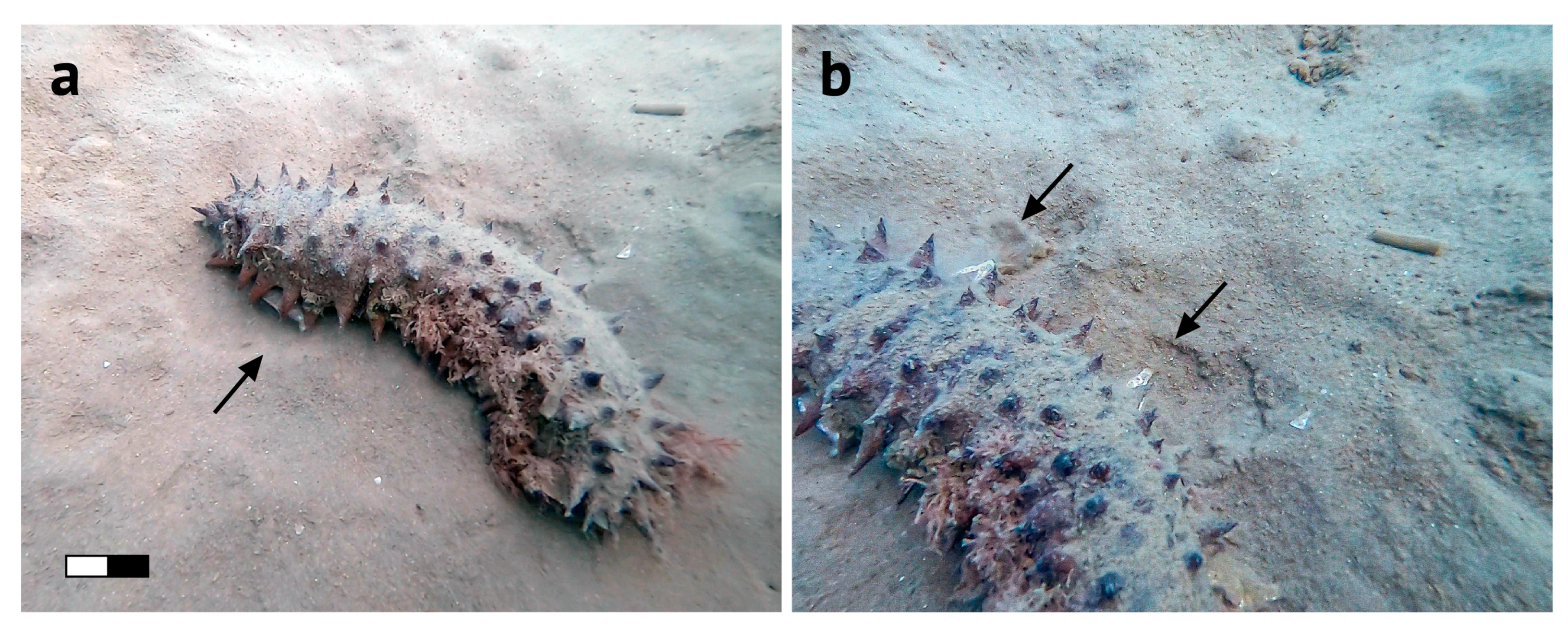Sea Cucumber (Holothuria arguinensis) as a Shelter for Juvenile Fish (Diplodus bellottii) in the Gulf of Cadiz (Southwestern Spain)
Abstract
Supplementary Materials
Author Contributions
Funding
Institutional Review Board Statement
Data Availability Statement
Acknowledgments
Conflicts of Interest
References
- Sogard, S.M. Size-selective mortality in the juvenile stage of teleost fishes: A review. Bull. Mar. Sci. 1997, 60, 1129–1157. [Google Scholar]
- de Gier, W.; Fransen, C.H.J.M.; Ozten, A.L.; Hoeksema, B.W. Reef fishes stalking box crabs in the southern Caribbean. Ecology 2020, 101, e03068. [Google Scholar] [CrossRef] [PubMed]
- Le Pape, O.; Bonhommeau, S. The food limitation hypothesis for juvenile marine fish. Fish Fish 2015, 16, 373–398. [Google Scholar] [CrossRef]
- Hoeksema, B.W.; Van der Meij, S.; Fransen, C.H.J.M. The mushroom coral as a habitat. J. Mar. Biol. Assoc. UK 2012, 92, 647–663. [Google Scholar] [CrossRef]
- Kerry, J.; Bellwood, D. The effect of coral morphology on shelter selection by coral reef fishes. Coral Reefs 2012, 31, 415–424. [Google Scholar] [CrossRef]
- Karplus, I. The associations between fishes and echinoderms. In Symbiosis in Fishes: The Biology of Interspecific Partnerships, 1st ed.; Karplus, I., Ed.; Wiley and Sons Ltd.: Hoboken, NJ, USA, 2014; pp. 371–430. [Google Scholar]
- Giglio, V.J.; Ternes, M.L.; Barbosa, M.C.; Cordeiro, C.A.; Floeter, S.R.; Ferreira, C.E. Reef fish associations with sea urchins in an Atlantic oceanic island. Mar. Biodivers. 2018, 48, 1833–1839. [Google Scholar] [CrossRef]
- Grande, H.; Reis, M.; Carvalho, N.F. Use of the sea urchin Diadema antillarum (Echinodermata, Echinoidea) as a shelter for non-cryptobenthic juvenile reef fishes. Mar. Biodivers. 2020, 50, 53. [Google Scholar] [CrossRef]
- Purcell, S.W.; Eriksson, H. Echinoderms piggybacking on sea cucumbers: Benign effects on sediment turnover and movement of hosts. Mar. Biol. Res. 2015, 11, 666–670. [Google Scholar] [CrossRef]
- Purcell, S.W.; Conand, C.; Uthicke, S.; Byrne, M. Ecological roles of exploited sea cucumbers. Oceanogr. Mar. Biol. Annu. Rev. 2016, 54, 367–386. [Google Scholar]
- Caulier, G.; Lepoint, G.; Van Nedervelde, F.; Eeckhaut, I. The diet of the Harlequin crab Lissocarcinus orbicularis, an obligate symbiont of sea cucumbers (holothuroids) belonging to the genera Thelenota, Bohadschia and Holothuria. Symbiosis 2014, 62, 91–99. [Google Scholar] [CrossRef]
- Fransen, C.H.J.M.; Hoeksema, B.W. Going for the stars: Extending the host record for the reef-dwelling Emperor shrimp, Periclimenes imperator (Pontoniinae). Mar. Biodivers. 2014, 44, 465–466. [Google Scholar] [CrossRef]
- Eeckhaut, I.; Parmentier, E.; Becker, P.; Gomez da Silva, S.; Jangoux, M. Parasites and biotic diseases in field and cultivated sea cucumbers. In Advances in Sea Cucumber Aquaculture and Management, 1st ed.; Lovatelli, A., Ed.; FAO: Rome, Italy, 2004; Fisheries Technical Paper 463; pp. 311–325. [Google Scholar]
- González-Wangüemert, M.; Maggi, C.; Valente, S.; Martínez-Garrido, J.; Vasco-Rodrigues, N. Parastichopus regalis—The main host of Carapus acus in temperate waters of the Mediterranean Sea and northeastern Atlantic Ocean. SPC Beche-de-mer Inf. Bull. 2014, 34, 38–42. [Google Scholar]
- Parmentier, E.; Mercier, A.; Hamel, J.-F. New host and geographical distribution for the pearlfish Carapus mourlani (Carapidae) with a discussion on its biology. Copeia 2006, 2006, 122–128. [Google Scholar] [CrossRef]
- González-Ortegón, E.; (Instituto de Ciencias Marinas de Andalucía, Puerto Real, Cadiz, Spain). Personal communication, 2022.
- Barea, C.N.; Albarral, D.G.; González, C.O. Marine Protection Areas for Fishing in Andalousia. Rev. Gest. Cost. Integr. 2012, 12, 453–462. [Google Scholar]
- Frid, A.; Dill, L. Human-caused disturbance stimuli as a form of predation risk. Cons. Ecol. 2002, 6, 11. [Google Scholar] [CrossRef]
- Ventura, D.G.; Lasinio, J.; Ardizzone, G. Temporal partitioning of microhabitat use among four juvenile fish species of the genus Diplodus (Pisces: Perciformes, Sparidae). Mar. Ecol. 2014, 36, 1013–1032. [Google Scholar] [CrossRef]
- Horta, M.; Costa, M.J.; Cabral, H. Spatial and trophic niche overlap between Diplodus bellottii and Diplodus vulgaris in the Tagus estuary, Portugal. J. Mar. Biol. Assoc. UK 2004, 84, 837–842. [Google Scholar] [CrossRef]

Publisher’s Note: MDPI stays neutral with regard to jurisdictional claims in published maps and institutional affiliations. |
© 2022 by the authors. Licensee MDPI, Basel, Switzerland. This article is an open access article distributed under the terms and conditions of the Creative Commons Attribution (CC BY) license (https://creativecommons.org/licenses/by/4.0/).
Share and Cite
De Carvalho-Souza, G.F.; Roque-Atienza, D.; González-Ortegón, E. Sea Cucumber (Holothuria arguinensis) as a Shelter for Juvenile Fish (Diplodus bellottii) in the Gulf of Cadiz (Southwestern Spain). Diversity 2022, 14, 872. https://doi.org/10.3390/d14100872
De Carvalho-Souza GF, Roque-Atienza D, González-Ortegón E. Sea Cucumber (Holothuria arguinensis) as a Shelter for Juvenile Fish (Diplodus bellottii) in the Gulf of Cadiz (Southwestern Spain). Diversity. 2022; 14(10):872. https://doi.org/10.3390/d14100872
Chicago/Turabian StyleDe Carvalho-Souza, Gustavo F., David Roque-Atienza, and Enrique González-Ortegón. 2022. "Sea Cucumber (Holothuria arguinensis) as a Shelter for Juvenile Fish (Diplodus bellottii) in the Gulf of Cadiz (Southwestern Spain)" Diversity 14, no. 10: 872. https://doi.org/10.3390/d14100872
APA StyleDe Carvalho-Souza, G. F., Roque-Atienza, D., & González-Ortegón, E. (2022). Sea Cucumber (Holothuria arguinensis) as a Shelter for Juvenile Fish (Diplodus bellottii) in the Gulf of Cadiz (Southwestern Spain). Diversity, 14(10), 872. https://doi.org/10.3390/d14100872







